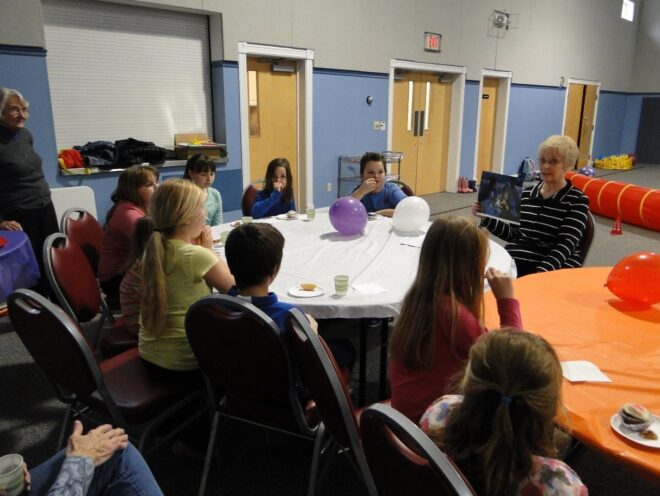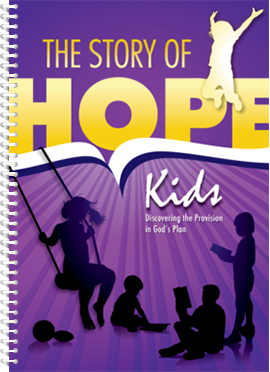Engaging Kids in Bible Learning

Three of my “all-boy” great nephews and their sister grabbed their jackets and tore out the door, unusually eager to get to church for the Purim party their teacher had promised. Ages 12, 10, 9 and 7, they enthusiastically participated in the special activities. They had been captivated by their teacher’s message and methods and entered the party atmosphere wholeheartedly. Mothers on the sidelines commented, “We can’t get our children this motivated!” Yes, children can be captivated by the messages of the Bible, when connected to methods that fully engage them in the learning process.
As we, Karen and Edie, have taught the Bible to children for many years we have learned how important it is to actively engage them in Bible learning. Here are a few examples of Bible teaching-learning activities we have used:
I am reminded of when we taught Bible in a summer day camp. The children ran to the pavilion, hollering loudly, “Can I help?” “No, I want to!” Our teaching then, as it often is, was in 3-D. Blue tarps became the Sea of Galilee beside the tan “sand” sheets. A refrigerator box was fashioned into a boat; a dessert scene was painted onto a backdrop. Selected children donned scarves and pieces of colorful cloth and crowded into the “boat” with one boy holding an oar. “Fish” (Pepperidge Farm Goldfish® crackers) were buried in the “sea.” Those not participating looked on spell-bound as the Bible story unfolded, a story most of them had already heard.

At a children’s missions conference, we highlighted Ukraine and told ABWE’s visualized missionary story “Kubanka Kids.” Our dimensional relief map of Ukraine combined Matchbox cars, Playmobile people, trees from my Christmas village, erasers turned into houses, and toy rubber soldiers lined the eastern border. Everything was strategically placed on a piece of foam board on which we’d drawn the outline of Ukraine with some of its roads, rivers and railroads. The kids inspected the Ukrainian curios also on display, but the map drew them in every session. And, as they moved the figures and vehicles, we shared bite-sized bits of information about how the kids in Ukraine need to hear about the Chronological Bridge to Life.

And speaking of the Chronological Bridge to Life, ten small cardboard boxes from Walmart became the “Bridge” over which we moved a gaucho cowboy doll from Argentina as we explained God’s redemptive plan in words kids could understand. The eight important words - God, Man, Sin, Death, Christ, Cross, Faith, and Life – were illustrated on each box. We also used The Chronological Bridge to Life Visuals and displayed them as we taught the eight key words. Then it was the children’s turn, so at the appropriate time a child was chosen to move the gaucho cowboy to the next block while explaining what the word on the block meant.



Children all around the world learn in a myriad of ways (see the 9 Types of Intelligence Infographic), so we apply varied activities and visuals that engage kids' thinking in order to heighten comprehension, clear misconceptions, and ensure retention. We plant the seed and pray for lasting fruit. Well-written work sheets also have a valuable role in teaching. Children eagerly interact with multiple choice questions, fill-in-the-blanks, and true and false questions. The Story of Hope – Kids provides an excellent way for children to search the Scriptures and write what they discover. Each of the 40 (20 Old Testament and 20 New Testament) Bible events covered in this workbook have a page devoted to each of the 40 events. Scripture references, a key statement, full-color illustrations, and questions will engage a child’s mind. This Story of Hope – Kids workbook has multiple types of engaging activities: student-directed, teacher with student, class workbooks, and follow-up with a child who has just professed to place his or her faith in Christ.


Today’s children are very much “hands on,” so providing manipulatives (hands-on learning materials) enhance reality and spark imagination. When it came time to teach Nehemiah and the rebuilding of Jerusalem’s walls, we took our Duplo blocks and Legos to church! Beforehand, we constructed a modified outline of the city wall, with all the gates labeled, the Temple, and other buildings plus people. Kids in both VBS and Sunday School were fascinated with the model. As they moved the Lego people about, we talked about what Nehemiah accomplished with God’s help. The kids were captivated! Who knew Legos could go to church?

Years ago, I crafted a five-foot cross from cardboard and attached it to a wooden pole on a base. This 3-D visual has traveled widely and has been helpful in teaching why Jesus had to die. Sometimes, when discussing “sin” with children, we distribute sticky notes and invite the children to print sins which children commit. Then they place their note on the cross. We’ve used our “paper bag altar” and a stuffed lamb to explain the sacrifices God instituted in the Old Testament. It’s always been a very sober time in the teaching hour when children see the altar or cross. They seem to walk away with a meaningful understanding of redemption. Another visual we’ve found useful is a large 3-D scene of heaven. This has been displayed or held by children and has generated good discussion about heaven, what it’s like, and who goes there. If you teach children who learn best visually, providing “out of the norm” flat and 3-D visuals will captivate them and enhance their learning experiences.

If you are looking for an easy-to-use curriculum that will take your children through the Bible from Genesis to Revelation, Adventures in the Story of Hope may be just what you need. This free download provides a comprehensive Bible curriculum that has been used successfully with children worldwide. Complete with 41 lesson plans for the teachers, a children's adaptation of The Story of Hope, memory verses, 12 songs, fun ways to tell each story, activities, and much more, your kids will buzz with excitement while learning the truths from God's word! There's even a unique way for children to tell the story to their own friends and family called “My Story of Hope."

Whatever methods you use to teach children, whether teacher to student (stories), student to teacher (recitation, reports, singing), two-way (question and answer, discussion, small buzz groups) or out-of-class (research projects), your aim is to engage your class and involve them in the learning process so that they will so interested they won’t realize how much they are learning. As they internalize the Scriptures, knowingly or unknowingly, God’s Spirit will move upon their hearts and lives will be changed.
- Karen Weitzel and Edie Cunningham

Learn more about how Good Soil E&D is for Ministry with Children

Learn more about The Chronological Bridge to Life Visuals

Learn more about The Story of Hope - Kids

Learn more about Adventures in the Story of Hope

Learn more about Kubanka Kids; Stories from the Ukraine




